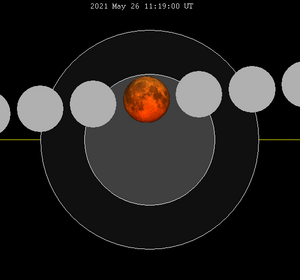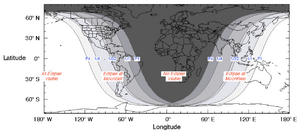May 2021 lunar eclipse facts for kids
A total lunar eclipse happened on 26 May 2021. This was the first time the Moon was completely covered by Earth's shadow since January 2019. People in many parts of the world could see this amazing event. It was visible in areas like southeast Asia, all of Australia, all of Oceania, most of Alaska and Canada, all of the lower 48 states in the USA, all of Hawaii, and most of South America.
Contents
What is a Lunar Eclipse?
A lunar eclipse happens when the Earth passes directly between the Sun and the Moon. This makes the Earth block the Sun's light from reaching the Moon. Imagine the Earth casting a big shadow into space. When the Moon moves into this shadow, we see a lunar eclipse.
Types of Lunar Eclipses
There are three main types of lunar eclipses:
- Total Lunar Eclipse: This is when the entire Moon enters the darkest part of Earth's shadow, called the umbra. During a total eclipse, the Moon often turns a reddish or orange color.
- Partial Lunar Eclipse: This happens when only part of the Moon enters the umbra. You'll see a dark "bite" taken out of the Moon.
- Penumbral Lunar Eclipse: This is when the Moon passes through the lighter, outer part of Earth's shadow, called the penumbra. These are often hard to notice because the Moon only dims slightly.
Why the Moon Turns Red
During a total lunar eclipse, the Moon doesn't disappear completely. Instead, it often looks reddish or orange. This is why it's sometimes called a "Blood Moon." This happens because some sunlight still reaches the Moon. The light passes through Earth's atmosphere, which scatters blue light more than red light. This is the same reason sunsets look red! The red light then bends and hits the Moon, making it glow with a reddish hue.
The 26 May 2021 Eclipse
The total lunar eclipse on 26 May 2021 was a special event for many sky-watchers. It was the first total lunar eclipse in over two years. People in the areas mentioned earlier had the best views. The eclipse started as the Moon entered the lighter penumbral shadow, then slowly moved into the darker umbral shadow, where it turned red.
Where it Could Be Seen
This eclipse was best seen from places around the Pacific Ocean. This included:
- Most of North America (especially the western parts)
- All of South America
- All of Australia
- All of Oceania (islands in the Pacific)
- Parts of Asia (especially Southeast Asia)
People in other parts of the world, like Europe or Africa, could not see this particular eclipse because the Moon was not in the right position in the sky for them during the event.
Images for kids
-
This animation shows the Moon moving west to east, passing into the shadow of Earth in Scorpius near the Milky Way. It first enters the outer penumbral shadow, and then the dark umbral shadow. Here, the brightness of the moon is exaggerated within the umbral shadow. The southern part of the moon is darkest due to it being closest to the centre of the shadow.
-
Garrett County, Maryland, 9:43 UTC
-
Minneapolis, Minnesota, 10:19 UTC
-
Berwick Forest, New Zealand, 10:52 UTC
-
Taoyuan, Taiwan, 11:02 UTC
-
Canberra, Australia, 11:11 UTC
-
Manila, Philippines, 11:13 UTC
-
Laguna, Philippines, 11:15 UTC
-
Geelong, Victoria, 11:23 UTC
-
Tarlac, Philippines, 11:32 UTC
-
New South Wales, Australia, 12:01 UTC
-
New South Wales, Australia, 12:21 UTC
-
Chennai, India, 13:27 UTC
See also
 In Spanish: Eclipse lunar de mayo de 2021 para niños
In Spanish: Eclipse lunar de mayo de 2021 para niños



















